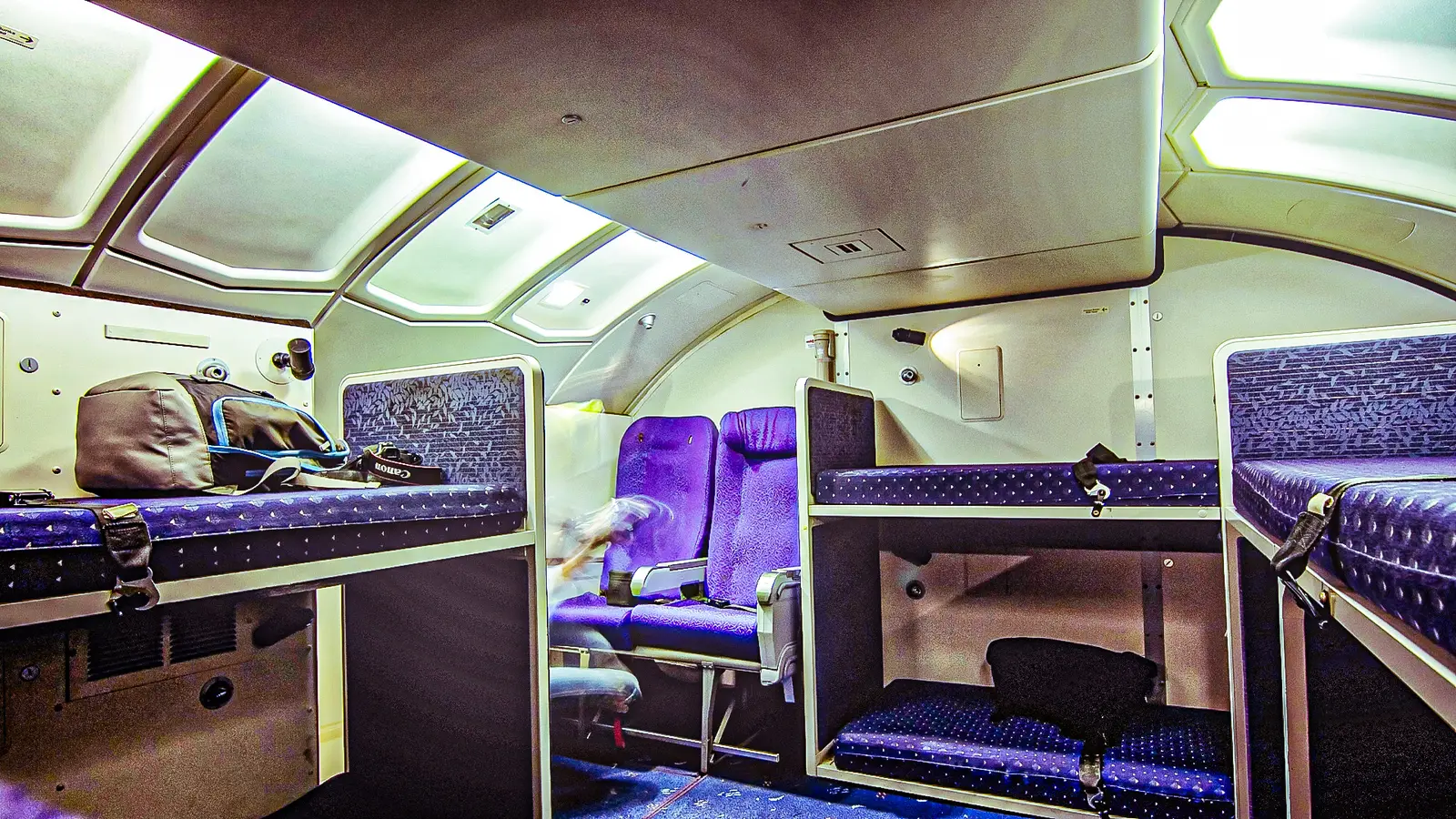Copyright Simple Flying

With airlines introducing longer routes and aircraft that can travel farther than ever before, layovers could be a thing of the past for some passengers. The ultra-long-haul flight can mean flying for 20+ hours or more, whereas the maximum long-haul flight was around 14 hours. With this prospect in mind, it means a long duty period for cabin crew and 24 hours on duty. In this guide, we will look at where cabin crew rest during their duty and how best to maximize rest. Crew rest areas are hidden from the main cabin and are usually above or below it. They are small, cramped areas that house bunk beds or mattresses with dividing curtains. Although not the most comfortable, they are crucial for the crew to get some rest during long-haul flights, as they need to remain alert to handle any emergency. Flight deck crew rest areas are close to the cockpit, whereas cabin crew rest areas are usually near the tail, either under or over the main cabin. Crew Rest Areas Crew rest areas are essential for the crew to take a break during a long-haul night flight, which most flights are. Inside each bunk is a pillow, a blanket, and a seatbelt. The seatbelt is an essential feature, as most cabin crew rest areas are near the tail of the aircraft. In turbulence, it can get quite uncomfortable, and it is vital to be strapped in. There is usually a reading light, a small storage space, and a hook for clothing. Some are in a one-up, one-down configuration, and others are side-by-side, sometimes nicknamed 'coffins'. These may be entered from the side or the end, depending on the type. There are usually between six and ten bunks in the crew rest area. The flight crew rest areas are separate, close to the cockpit, and typically have two bunks and, sometimes, a reclining chair. These areas are used only when four flight crew members are operating. Cabin crew try to make the most of their rest period by being as comfortable as possible. They may change out of their uniforms into more comfortable clothing. Some take their own travel-size pillow, a small duvet or comforter and a small hot water bottle as it can be quite cold on night flights. They also have a toiletries/makeup kit to freshen up after the flight and to be well-presented in uniform once again. How Crew Plan Their Rest Periods When you take a long-haul flight, there are usually two meal services, one at around one to two hours after take-off and the second around two and a half hours before landing. Therefore, the remaining time during the flight is divided into two rest periods, during which half the crew will go to the rest area whilst the other half remains on duty. Crew rest is usually between one-and-a-half hours and three-and-a-half hours, depending on the overall flight time. During training, cabin crew learn about fatigue management and how to adapt best whilst on duty and off. This may mean sleeping for a few hours before a night flight and sleeping during the day, once back. Even with crew rest, it is not always easy to sleep on demand with an upset body clock, and the aircraft can be noisy and crew rest uncomfortable. Adrenaline also kicks in during night flights, when you would normally be asleep. In this case, the cabin crew takes rest the best they can by watching a movie or listening to music. 90 minutes is the optimal time for rest or sleep to temporarily reset the body clock and recharge before going back on duty. Once down route, most cabin crew will go to sleep as soon as they arrive at the hotel, as they have already been on duty for an extended period. Some crew find it easier to stay on home time, and others adapt to local time, whatever eases jet lag for them. As a rule, it is important to sleep when you need to, eat when you need to, and drink plenty of water. Go for a walk and get some fresh air. Once back at home, the same applies; long-haul crew often arrive in the early morning and then sleep during the day to recover. How Flights Are Scheduled A long-haul flight is planned with fuel efficiency and minimum flight time in mind. It determines the most efficient flight route by taking into account weather conditions, airspace restrictions, and air traffic congestion. A flight planner will use special equipment and coordinate with air traffic control to prepare a flight plan. Aircraft are kept in optimal condition by engineers and inspected thoroughly before long-haul flights. Schedulers must comply with flight time limitations (FTLs), and the flight and cabin crew rosters are prepared in advance to allow for rest and duty time. Fuel management is essential for long-haul flights. Airlines calculate the required amount of fuel based on flight distance, aircraft weight, alternate airports, and wind conditions. Minimizing excess weight reduces fuel consumption. When scheduling an ultra-long-haul flight, two additional pilots are required to ensure safety, especially during critical phases. After four hours, the flight crew will swap places and rest. The cabin crew will rotate every two or three hours. These kinds of flights can never be full, and crew and fuel cannot be reduced; therefore, cargo payload and passenger numbers are reduced to make them effective. Ultra Long Haul Flights In October 2025, Xiamen Airlines operated the world's longest flight, departing from John F. Kennedy International Airport (JFK) to Fuzhou (FOC) in Southern China, with a flight time of 19 hours and 20 minutes. The flight is longer than usual as it avoids Russian airspace. Opinions are still divided on whether it is better to fly an ultra long range flight direct or with a layover, according to AFAR. Newer aircraft are more fuel-efficient than ever before and can hold more fuel while burning less. With jet lag reducing lighting, larger windows, lower cabin altitude and more comfortable seating, longer flights are becoming possible for passengers who would otherwise have had a layover. Business travelers, especially, are seeing the benefits of getting to their destination faster. The top five longest flights in 2025: Turkish Airlines plans to have direct flights between Istanbul Airport (IST) and Sydney Kingsford Smith Airport (SYD) in 2026, a distance of 9,300 nautical miles and a flight time of 17 hours. They also plan direct flights between Istanbul and Melbourne Airport (MEL) in 2027. Qantas aims to fly from Sydney to London and New York direct in 2027. From Sydney to London is 10,573 nautical miles, and an expected flight time of 20 hours, and the Sydney to New York route is slightly less. The Future Of Crew Rest? Most cabin crew have been on duty for around 12 hours, but can be up to 17 hours on long-haul flights such as Singapore to London. There are also flight duty limitations in place that cannot be exceeded. These are strict rules set by aviation authorities to ensure that flight and cabin crew can operate safely and effectively and respond to emergencies. These rules are in respect to flight time, duty time and rest time. Early starts, late finishes, and night flights also have to be taken into consideration. The flight duty period from reporting for duty to engine shut down, should not exceed 13 hours plus one hour 'discretion'. Minimum rest time is 12 hours prior to flight and 10 hours away from base (EASA) or greater if the preceding duty is longer than 12 hours. Cabin crew have to have a minimum of 7 days off per month. They can work up to 60 duty hours in 7 days, 110 hours in 14 days, and 190 hours in 28 days. Flight time must not exceed 100 hours in 28 days and 900 hours in a year (UK) or 1000 hours (Europe). A duty period over 14 hours requires a minimum of three hours of rest, and for periods over 18 hours, a minimum of 4.5 hours is needed. With more advanced aircraft and longer flights being the future, there will have to be changes to flight time limitations and how crew are scheduled to ensure safe and efficient flights. Improved crew rest areas ( Singapore Airlines new Airbus A350-1000 ULR aircraft has a larger crew rest area), more rest periods, and augmented crew may be an option. For cabin crew, working a 20-plus-hour flight, means a 24-hour duty. At the current time, we don't know the impact of missing two nights' sleep. On such flights, there are four or more flight crew to operate sectors safely, but for cabin crew, we will soon see. Rounding Things Up There is no doubt that with longer flights and longer duty periods, it will be more important than ever to have more crew rest periods. Until recently, the longest flight was from New York to Singapore, but now it is from New York to Fuzhou at 19 hours and 20 minutes. Qantas has been launching 'Project Sunrise' flights with flights exceeding 19 hours, from Sydney to London and New York. Air New Zealand flies from New York to Auckland in around 17 hours and 30 minutes, though it can take anywhere from 15 to 18 hours, depending on conditions. Everyone is different when it comes to schedules and crossing time zones; flying east can be challenging for both passengers and crew. It is always important to rest when you can, for at least 90 minutes. Once down route, crew will either stay on home time or adapt to local time, depending on which works better for them, but most of all, they sleep when they can to gain maximum rest.



